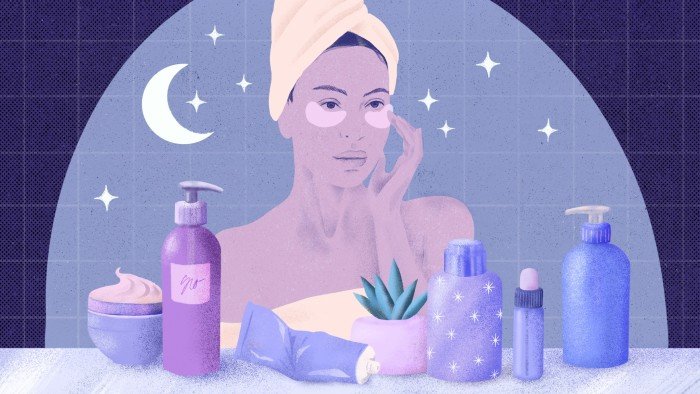Alexis Jacobo’s get-ready-with-me (GRWM) routine takes three hours. If you are one of her 1.29mn YouTube subscribers, perhaps you have watched the highlights.
At 7pm, she runs a bath. At 7.40pm she begins her skincare routine (including sheet mask and lip mask). Her haircare regime commences around 20 minutes later, followed by body care (lotion, oil, perfume). Tidying and outfit prep are followed by journaling, before tea, reading, tooth brushing, the filling of a Stanley Cup (of course) and pillow spray application. She isn’t getting ready to go out, you see. She’s preparing for bed.
Pre-bed routines were once sacrosanct, private rituals in which you locked the door on the outside world, and peeled off the layers of armour used to face it. Not any more.
“Get Ready With Me videos have been part of YouTube since the beginning, but their popularity continues to grow,” says Roya Zeitoune, the social media platform’s culture and trends manager for Europe, the Middle East and Africa. Between January and November 2024, more than 400,000 uploads of videos with “GRWM” in the title had been posted on the platform, many of which show the laborious make-up and hair routines employed by influencers typically before they leave the house in the morning.
While YouTube isn’t able to distinguish the time of day each GRWM video takes place, Zeitoune believes that bedtime GRWM have a special power. “The intimacy of sharing routines, especially for getting ready for bed, helps users feel a deeper connection to the content,” she says. “GRWM videos also mirror a broader shift towards prioritising wellbeing. Skincare is self-care, and that interest is exploding. So the combination of comfort with inspiration can make you feel better inside and out.”
In common with those of other influencers, Jacobo’s routine is highly structured. In fact, it reminds me of the regimented routines that desperate new parents implement in an attempt to get their fractious newborn to sleep. But could they actually be good for us, “inside and out”, as Zeitoune suggests? Or is the trend just another opportunity for beauty brands to sell us more things we really don’t need?
We dismiss the deeper value of seemingly superficial beauty regimes at our peril, suggests psychologist Sandra Wheatley. “Whether it’s planning tomorrow’s outfit or doing your eyebrows . . . The action itself may be frivolous, but the decision to place yourself slightly higher up on your list of priorities isn’t,” she says. “From a psychological point of view, the act of making yourself feel slightly more important than you currently do is very powerful. Bigger, more profound things follow from these small steps.”
These routines may be even more impactful at night, suggests Russell Foster, professor of circadian neuroscience at Oxford university. The myth of beauty sleep is founded in reality, he suggests: “One of the important things going on while we sleep is tissue repair. Growth hormone, for example, which is involved in tissue repair, is released in the first part of your sleep episode. If you don’t get sleep, you truncate the amount of growth hormone released. So there would be a correlation between tissue repair and sleep, and without tissue repair we will develop more wrinkles.”
But does it matter what beauty products and processes one incorporates into a bedtime routine?
“For many skincare products, such as basic cleansers and moisturisers, the timing of application doesn’t significantly affect their efficacy, as their primary function isn’t dependent on skin’s circadian rhythms,” says Dr Anjali Mahto, consultant dermatologist and founder of the Self London clinic. However, she caveats that night-time application is fundamental for products with active ingredients, like retinol: “Exposure to sunlight can degrade it, reducing its effectiveness and increasing the risk of skin irritation. At night, away from UV exposure, retinol can penetrate the skin and promote cell turnover more effectively.”
There are other reasons too why a good evening routine may be particularly important for your skin. Its barrier function is slightly less efficient overnight, explains Mahto, leading to a process called transepidermal water loss — or dehydration. Applying a hydrating night cream before bed helps counteract this, she says, especially if it contains occlusive agents like shea butter or petrolatum to form a barrier on the skin’s surface, preventing moisture loss. Ingredients like hyaluronic acid or glycerine, which attract and retain water, can also boost hydration levels during this important phase.
What about hair? Can you make a bigger difference to its health and appearance overnight than in the morning? “You absolutely can,” says Adam Reed, celebrity hair stylist and founder of hair and scalp care brand Arkive. Leaving a treatment in overnight, he notes, simply gives it longer to work. Reeds’ recommended bedtime routine begins with a thorough brushing: “It’s a great way of removing any hair that’s falling out, and working the natural oils through your hair which helps to condition.”
Reeds also believes in the benefits of slugging: “Work oil through your dry hair, root to tip, brush again then secure with a silk scarf or braid it up, so the product penetrates the hair shaft overnight.” However, unlike skincare, this will involve a little extra work in the morning too. “Put your normal liquid shampoo through dry hair and massage it until it’s thoroughly worked in,” he advises. Then, “slowly start adding water to emulsify. Otherwise the oil or the treatment will push the water away.” The result? “Beautifully glossy, shiny, soft hair,” says Reed, “and it’s as good for how you feel as how you look. My grandmother used to say: 100 strokes of the hairbrush before bed is a great way to fall asleep.”
To get the most out of these practices, you have to revel in and relish them, he believes: “Often, when I see these [GRWM] videos, it doesn’t look like they’re treating their routines like a proper ritual.” They are, he observes, too rushed. The beauty of evening routines, as opposed to morning ones, is that they are done when you are not rushing to catch a train or morning meeting. You should be able to luxuriate in your bedtime rituals, not treat them as an arduous to-do list.
Partly for that reason, Mahto is not a fan. “A lot of my patients with skin issues have watched these videos and felt a degree of FOMO [fear of missing out],” she says. “They tend to encourage unnecessarily complex or expensive routines, fostering unrealistic expectations and financial strain. In reality, most people benefit from simple, well-tailored routines that address their specific needs without overloading the skin.”
“These things are detrimental to us when we feel they’re something we should live up to, but beneficial to us when they’re something we choose to do,” summarises Wheatley. In other words, routines are good for your beauty sleep, but anxiously trying to replicate those promoted by influencers probably is not.
Follow us on Instagram and sign up for Fashion Matters, your weekly newsletter about the fashion industry









